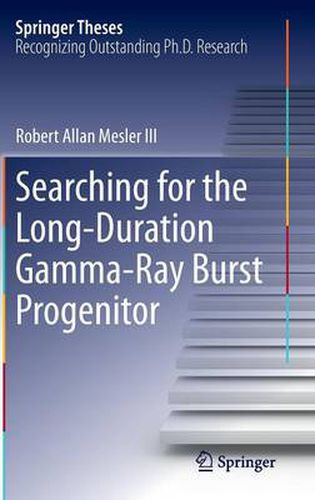Readings Newsletter
Become a Readings Member to make your shopping experience even easier.
Sign in or sign up for free!
You’re not far away from qualifying for FREE standard shipping within Australia
You’ve qualified for FREE standard shipping within Australia
The cart is loading…






This title is printed to order. This book may have been self-published. If so, we cannot guarantee the quality of the content. In the main most books will have gone through the editing process however some may not. We therefore suggest that you be aware of this before ordering this book. If in doubt check either the author or publisher’s details as we are unable to accept any returns unless they are faulty. Please contact us if you have any questions.
Nominated as an outstanding thesis by the Department of Physics and Astronomy of the University of New Mexico, this thesis seeks to identify the gamma-ray burst (GRB) progenitor. GRBs are extragalactic explosions that briefly outshine entire galaxies, but the mechanism that can release that much energy over a < 100 second burst is still a mystery. The leading candidate for the GRB progenitor is currently a massive star which collapses to form a black hole-accretion disk system that powers the GRB. GRB afterglows, however, do not always show the expected behavior of a relativistic blast wave interacting with the stellar wind that such a progenitor should have produced before its collapse.
In this book, the author uses the Zeus-MP astrophysical hydrodynamics code to model the environment around a stellar progenitor prior to the burst. He then develops a new semi-analytic MHD and emission model to produce light curves for GRBs encountering these realistic density profiles. The work ultimately shows that the circumburst medium surrounding a GRB at the time of the explosion is much more complex than a pure wind, and that observed afterglows are entirely consistent with a large subset of proposed stellar progenitors.
$9.00 standard shipping within Australia
FREE standard shipping within Australia for orders over $100.00
Express & International shipping calculated at checkout
This title is printed to order. This book may have been self-published. If so, we cannot guarantee the quality of the content. In the main most books will have gone through the editing process however some may not. We therefore suggest that you be aware of this before ordering this book. If in doubt check either the author or publisher’s details as we are unable to accept any returns unless they are faulty. Please contact us if you have any questions.
Nominated as an outstanding thesis by the Department of Physics and Astronomy of the University of New Mexico, this thesis seeks to identify the gamma-ray burst (GRB) progenitor. GRBs are extragalactic explosions that briefly outshine entire galaxies, but the mechanism that can release that much energy over a < 100 second burst is still a mystery. The leading candidate for the GRB progenitor is currently a massive star which collapses to form a black hole-accretion disk system that powers the GRB. GRB afterglows, however, do not always show the expected behavior of a relativistic blast wave interacting with the stellar wind that such a progenitor should have produced before its collapse.
In this book, the author uses the Zeus-MP astrophysical hydrodynamics code to model the environment around a stellar progenitor prior to the burst. He then develops a new semi-analytic MHD and emission model to produce light curves for GRBs encountering these realistic density profiles. The work ultimately shows that the circumburst medium surrounding a GRB at the time of the explosion is much more complex than a pure wind, and that observed afterglows are entirely consistent with a large subset of proposed stellar progenitors.